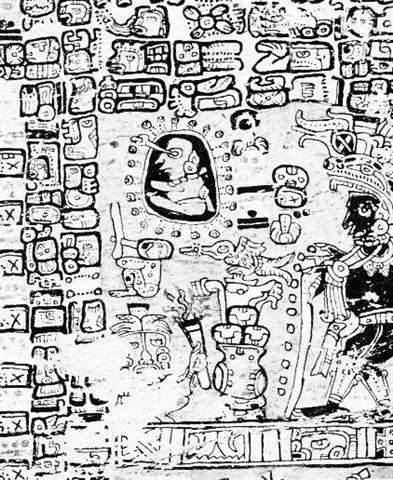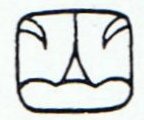83. Could the
corresponding
hakaariki
glyph in the G
text possibly relate
to the
dates in the Roman frame of
time?
|
MAY 1 (*41) |
205 |
NOV 23 |
24 (*248) |
121 |
 |
 |
 |
|
Ga2-11 (41) |
Gb1-18 (41
+ 183 + 23) |
Gb1-19 (248) |
|
ºJune 30 (181)
heliacal SIRIUS |
'June 30 (364 - 183)
"June 16 (350 - 183) |
'July 1 (182)
17 (168 = 182 - 14) |
|
ºDec 30 (181 + 183) |
'Dec 30 (364)
nakshatra SIRIUS |
31 (*285)
"Dec 17 (*271 = *285 - 14) |
|
NUNKI (*288) |
|
Helical dates: |
|
MARCH 26 (*5) |
27 |
28 |
3-29 (88) |
30 |
|
Close to the Full Moon: |
|
SEPTEMBER 25 |
26 |
27 (270) |
28 |
29 (2 * 136) |
 |
 |
 |
 |
 |
|
Gb5-17 (370) |
Gb5-18 |
Gb5-19 |
Gb5-20 (144 = 2 * 72) |
Gb5-21 |
|
no star listed (69) |
no star listed (70) |
TABIT (Endurer) = π³ Orionis
(71.7), π² Orionis (71.9) |
π4 Orionis (72.1), ο¹ Orionis (72.4), π5
Orionis (72.8) |
π¹ Orionis (73.0), ο² Orionis (73.4),
HASSALEH = ι Aurigae
(73.6), π6 Orionis (73.9) |
|
May 29 |
30 |
31 (*71) |
June 1
(152) |
2 |
|
°May 25 |
26 |
27 |
°May 25 (148) |
29 |
|
'May 2 (487 = 365 + 122) |
3 |
4 |
5 (125 = 88 + 37) |
6 |
|
"April 18 |
19 (*29) |
20 |
Vaitu Nui 21
(111) |
22 |

| 177 = 6 * 29½ |
3-29 (88) |
 |
| Ca9-27 (255 = 72 + 183) |
| etoru gagata hakaariki kia raua |
| HELIACAL DATE: |
| Tangaroa Uri 21 (294) |
| CLOSE TO THE FULL MOON: |
| June 1 (152 = 111 + 41 = *72 + 80) |
|
°May 28 (148 = 111 + 37) |
| (111) = Vaitu Nui 21 |
In Gb5-24 the hakaariki men are probably heliacal and moving ahead, not standing still facing the Full Moon (and us). In G it was thus a new Sun 'king' who should be inaugurated. On such an occasion drinking kava could have been the rule.
 |
 |
|
kava |
Gb5-25 (378) |
| Kava
1. Sour; salty: vai kava,
saltwater, sea; te kava o te haíga,
acrid underarm smell; tagata kava -
tagata kakara i te kava, man with smelly
armpits. 2. He-kava te haha, to be
thirsty. 3. To turn sour, to become
embittered, bad-tempered, exasperated (used
with manava): tagata manava kava,
bad-tempered, angry man. Vanaga.
Bitter, salt; vai kava,
brackish water; hakakava, to embalm;
kavakava, acid, sharp, bitter, salt,
spiritous, vinegar, poisonous, disagreeable;
akavakava, to make sharp;
hakakavakava, to make acid. P Pau.:
kava, disagreeable to the taste;
kavakava, acid, sharp. Mgv.: kava,
to be bitter, sour, acid, salt. Mq.: kava,
bitter. Ta.: ava, bitter, acid, salt.
Kavahia: 1. Comfort, comfortable, to
feast; hakakavahia, comfort,
comfortable. 2. Repulsive (of food),
disgusted; hakakavahia, repulsion.
Kavakava, rib;
moi kavakava, a house god G. P Mgv.:
vakavaka, the breast. Mq.: vakavaka,
vaávaá, rib. Ma.: wakawaka,
parallel ridges. We shall need all the
available material in order to determine the
germ sense of this word. Sa.: va'ava'a,
the breast-bone of a bird; fa'ava'a,
the frame as of a slate. To.: vakavaka,
the side. Fu.: vakavaka, the side
below the armpit. Ha.: hoowaa, to
make furrows. In all these we may see the
idea of ridge or depression, or of both, as
primal (Rapanui, Samoa, Marquesas, Maori,
Hawaii), and as secondary the part of the
body where such appearances is common
(Mangareva, Tonga, Futuna). Churchill.
Mgv.: kava, the
pepper plant and the drink made therefrom.
Ta.: ava, id. Mq.: kava, id.
Sa.: 'ava, id. Ma.: kawa, a
pepper. Kavakava, a fish. Sa.:
'ava'ava, id. Kavapui, a tree.
Ta.: avapuhi, a fragrant plant. Mq.:
kavapui, wild ginger. Sa.: 'avapui,
id. Ha.: awapuhi, id. Churchill. Mq.:
ava, a small fish of sweet water.
Sa.. 'ava'ava, a small fish. Ha.:
awa, a fish. Kakava, burnt. Sa.:
'a'ava, very hot. Churchill. |
|
... Indeed, at the rituals of the
installation, the chief is invested with the
'rule' or 'authority' (lewaa) over
the land, but the land itself is not
conveyed to him. The soil (qele) is
specifically identified with the indigenous
'owners' (i taukei), a bond that
cannot be abrogated. Hence the widespread
assertion that traditionally (or before the
Lands Commission) the chiefly clan was
landless, except for what it had received in
provisional title from the native owners,
i.e., as marriage portion from the original
people or by bequest as their sister's son
... The ruling chief has no corner on the
means of production. Accordingly, he cannot
compel his native subjects to servile tasks,
such as providing or cooking his daily food,
which are obligations rather of his own
household, his own line, or of conquered
people (nona tamata ga, qali kaisi sara). Yet
even more dramatic conditions are imposed on
the sovereignity at the time of the ruler's
accession. Hocart observes that the Fijian
chief is ritually reborn on this occasion;
that is, as a domestic god. If so, someone
must have killed him as a dangerous
outsider. He is indeed killed by the
indigenous people at the very moment of his
consecration, by the offering of kava
that conveys the land to his authority (lewaa)
... |
The idea of a
fertile armpit
could have been given expression in the C text:
 |
 |
 |
 |
 |
|
Ca9-16 (244) |
Ca9-17 |
Ca9-18 |
Ca9-19 |
Ca9-20 |
|
E rima ki te henua |
koia ku honui |
erua maitaki |
ko koe ra |
|
Tangaroa Uri
10 |
11 |
12 (285) |
13 |
14 |
|
CLOSE TO THE FULL MOON: |
|
*61 |
BEID (Egg) |
HYADUM I |
HYADUM II |
AIN (Eye) |
|
...
A very
detailed myth comes from the island of
Nauru. In the beginning there was
nothing but the sea, and above soared
the Old-Spider. One day the Old-Spider
found a giant clam, took it up, and
tried to find if this object had any
opening, but could find none. She tapped
on it, and as it sounded hollow, she
decided it was empty. By repeating
a charm, she opened the two shells and
slipped inside. She could see nothing,
because the sun and the moon did not
then exist; and then, she could not
stand up because there was not enough
room in the shellfish. Constantly
hunting about she at last found a snail.
To endow it with power
she placed it under her arm, lay down
and slept for three days. Then she let
it free, and still hunting about she
found another snail bigger than the
first one, and treated it in the same
way. Then she said to the first snail:
'Can you open this room a little, so
that we can sit down?' The snail said it
could, and opened the shell a little. Old-Spider
then took the snail, placed it in the
west of the shell, and made it into the
moon. Then there was a little light,
which allowed Old-Spider to see a big
worm. At her request he opened the shell
a little wider, and from the body of the
worm flowed a salted sweat which
collected in the lower half-shell and
became the sea. Then he raised the upper
half-shell very high, and it became the
sky. Rigi, the worm, exhausted by
this great effort, then died. Old-Spider
then made the sun from the second snail,
and placed it beside the lower
half-shell, which became the earth ... |
|
... Then three lines are drawn east and
west, one across the northern section
indicates the northern limit of the Sun
(corresponding with the Tropic of
Cancer) about the 15th and 16th days of
the month Kaulua (i.e., the 21st
or 22nd of June) and is called ke
alanui polohiwa a Kane, the
black-shining road of Kane. The
line across the southern section
indicates the southern limit of the Sun
about the 15th or 16th days of the month
Hilinama (December 22) and is
called ke alanui polohiwa a Kanaloa,
the black-shining road of Kanaloa.
The line exactly around the middle of
the sphere is called ke alanui a ke
ku'uku'u, the road of the spider,
and also ke alanui i ka Piko a Wakea,
the way to the navel of Wakea
(the Sky-father) ...
 |
Moon crescents were growing under
the left respectively under the right arm - at the Egg
(ο¹ Eridani) respectively at the
Eye (ε Tauri).
And under the right respectively
the left
armpit there is a sign which should illustrate
the presence of the Sun (Father Light).
This sign is upside down, presumably to indicate
the situation when the image of the Sun was on
the face of the Full Moon. We can contrast this
inverted sign with the drawn up right knee of
daytime
Shu and also with the added sign in front in Gb1-5:

...
Hercules first appears in legend as a pastoral
sacred king and, perhaps because shepherds
welcome the birth of twin lambs, is a twin
himself. His characteristics and history can be
deduced from a mass of legends, folk-customs and
megalithic monuments. He is the rain-maker of
his tribe and a sort of human thunder-storm.
Legends connect him with Libya and the Atlas
Mountains; he may well have originated
thereabouts in Palaeolithic times. The priests
of Egyptian Thebes, who called him Shu,
dated his origin as 17,000 years before the
reign of King Amasis ...
|
NOVEMBER 6 |
7 (*231) |
8 |
9 |
10 (314) |
 |
 |
 |
 |
 |
|
Gb1-1 (230) |
Gb1-2 |
Gb1-3 |
Gb1-4 |
Gb1-5 |
|
January 9 |
10 (*295) |
11 |
12 |
13 (378) |
Light would increase in front.
In Ca9-16 henua is still in the dark, but
the usual hatch marks for indicating such a darkness
have here been changed to 4 signs of increase (<<<):
 |
 |
|
Ca9-16 |
Ca9-20 |
The standing tagata figure 4 nights
later has not the usual mata in both
directions (like Janus) but a sign of decrease
(left) balanced by a sign of increase towards the
front. This easily recognizable sign has been expanded to indicate
broad beams of light. We can compare with how the
powerful eye of the Mayan astronomer is reaching
out to a special star among 24:

At bottom of this picture is
Akbal (night), the 3rd day sign, but the
Mayan glyphs had their signs inside in contrast
to most of the rongorongo glyphs:

|
















